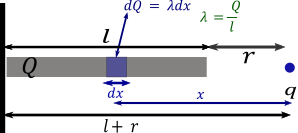
A line charge of length $l$ and charge $Q$ uniformly distributed over the length is placed at a distance $r$ from one edge from a point charge $q$ as shown. Find the force on the point charge:

A) $\dfrac{{qQ}}{{4\pi {\varepsilon _0}r\left( {r - l} \right)}}$
B) $\dfrac{{qQ}}{{4\pi {\varepsilon _0}\left( {r - \dfrac{1}{l}} \right)}}$
C) $\dfrac{{qQ}}{{4\pi {\varepsilon _0}\left( {\dfrac{1}{{{r^2}}} - \dfrac{1}{{{{\left( {r + l} \right)}^2}}}} \right)}}$
D) None of these.
Answer
219k+ views
hint: To solve this type question first we take a small segment of line charge. And assume it as a point charge due to this small segment (small charge) find the force on charge q. In the same manner we calculate force due to every small segment and add them or we can use integration methods to find force due to the whole line charge.We know force between two point charges is given by $F = \dfrac{1}{{4\pi {\varepsilon _0}}}\dfrac{{{q_1}{q_2}}}{{{r^2}}}$
Complete step by step solution:
Step 1 : First of all we assume a small segment of length $dx$ on line charge having $x$ distance from point charge $q$
As given length $l$ having charge $Q$ so the linear charge density given as $\lambda = \dfrac{Q}{l}$ means charge per unit length
As we can see in diagram

Segment $dx$ having a small charge can be given by $dQ = \lambda dx$
First we calculate the small force $dF$ on $q$ due to this segment which having charge $dQ$ and distance from $q$ charge is $x$
Apply formula for force between two point charges $F = \dfrac{1}{{4\pi {\varepsilon _0}}}\dfrac{{{q_1}{q_2}}}{{{r^2}}}$
Here ${q_1} = dQ$ and ${q_2} = q$ $r = x$
$ \Rightarrow dF = \dfrac{1}{{4\pi {\varepsilon _0}}}\dfrac{{qdQ}}{{{x^2}}}$
Segment $dx$ having a small charge can be given by $dQ = \lambda dx$
$ \Rightarrow dF = \dfrac{1}{{4\pi {\varepsilon _0}}}\dfrac{{q\lambda dx}}{{{x^2}}}$
Rearranging it
$ \Rightarrow dF = \dfrac{{q\lambda }}{{4\pi {\varepsilon _0}}}\dfrac{{dx}}{{{x^2}}}$
This is the small force on point charge $q$ due to small segment of $dx$
Step 2: If we want to calculate total force by $l$ length charge we have to integrate it
Total force due to $l$ length $Q$ charge $F$ can given as
$ \Rightarrow \int {dF} = \dfrac{{q\lambda }}{{4\pi {\varepsilon _0}}}\int\limits_r^{l + r} {\dfrac{{dx}}{{{x^2}}}} $
Net force
$ \Rightarrow F = \dfrac{{q\lambda }}{{4\pi {\varepsilon _0}}}\int\limits_r^{l + r} {{x^{ - 2}}dx} $
On integration
$ \Rightarrow F = \dfrac{{q\lambda }}{{4\pi {\varepsilon _0}}}\left[ {\dfrac{{{x^{ - 1}}}}{{ - 1}}} \right]_r^{l + r}$
$ \Rightarrow F = \dfrac{{q\lambda }}{{4\pi {\varepsilon _0}}}\left[ { - \dfrac{1}{x}} \right]_r^{l + r}$
Applying limits
$ \Rightarrow F = \dfrac{{q\lambda }}{{4\pi {\varepsilon _0}}}\left[ {\dfrac{1}{r} - \dfrac{1}{{\left( {l + r} \right)}}} \right]$
$ \Rightarrow F = \dfrac{{q\lambda }}{{4\pi {\varepsilon _0}}}\left[ {\dfrac{{l + r - r}}{{r\left( {l + r} \right)}}} \right]$
$ \Rightarrow F = \dfrac{{q\lambda }}{{4\pi {\varepsilon _0}}}\left[ {\dfrac{l}{{r\left( {l + r} \right)}}} \right]$
Now put value of linear charge density given by$\lambda = \dfrac{Q}{l}$
$ \Rightarrow F = \dfrac{{qQ}}{{4\pi {\varepsilon _0}l}}\left( {\dfrac{l}{{r\left( {l + r} \right)}}} \right)$
Solving again
$ \Rightarrow F = \dfrac{{qQ}}{{4\pi {\varepsilon _0}r\left( {l + r} \right)}}$
So the total force on the point charge $q$ is $ \Rightarrow F = \dfrac{{qQ}}{{4\pi {\varepsilon _0}r\left( {l + r} \right)}}$
So option D is correct.
Note:Sometimes students get confused why we use here the limit of integration is $r$ to $\left( {r + l} \right)$. See in diagram the distance between charge and segment of charge vary between $r$ to $\left( {r + l} \right)$ means the closest end of line charge is at distance $r$ and other end of this line charge having $\left( {r + l} \right)$ distance from point charge $q$ .
Complete step by step solution:
Step 1 : First of all we assume a small segment of length $dx$ on line charge having $x$ distance from point charge $q$
As given length $l$ having charge $Q$ so the linear charge density given as $\lambda = \dfrac{Q}{l}$ means charge per unit length
As we can see in diagram

Segment $dx$ having a small charge can be given by $dQ = \lambda dx$
First we calculate the small force $dF$ on $q$ due to this segment which having charge $dQ$ and distance from $q$ charge is $x$
Apply formula for force between two point charges $F = \dfrac{1}{{4\pi {\varepsilon _0}}}\dfrac{{{q_1}{q_2}}}{{{r^2}}}$
Here ${q_1} = dQ$ and ${q_2} = q$ $r = x$
$ \Rightarrow dF = \dfrac{1}{{4\pi {\varepsilon _0}}}\dfrac{{qdQ}}{{{x^2}}}$
Segment $dx$ having a small charge can be given by $dQ = \lambda dx$
$ \Rightarrow dF = \dfrac{1}{{4\pi {\varepsilon _0}}}\dfrac{{q\lambda dx}}{{{x^2}}}$
Rearranging it
$ \Rightarrow dF = \dfrac{{q\lambda }}{{4\pi {\varepsilon _0}}}\dfrac{{dx}}{{{x^2}}}$
This is the small force on point charge $q$ due to small segment of $dx$
Step 2: If we want to calculate total force by $l$ length charge we have to integrate it
Total force due to $l$ length $Q$ charge $F$ can given as
$ \Rightarrow \int {dF} = \dfrac{{q\lambda }}{{4\pi {\varepsilon _0}}}\int\limits_r^{l + r} {\dfrac{{dx}}{{{x^2}}}} $
Net force
$ \Rightarrow F = \dfrac{{q\lambda }}{{4\pi {\varepsilon _0}}}\int\limits_r^{l + r} {{x^{ - 2}}dx} $
On integration
$ \Rightarrow F = \dfrac{{q\lambda }}{{4\pi {\varepsilon _0}}}\left[ {\dfrac{{{x^{ - 1}}}}{{ - 1}}} \right]_r^{l + r}$
$ \Rightarrow F = \dfrac{{q\lambda }}{{4\pi {\varepsilon _0}}}\left[ { - \dfrac{1}{x}} \right]_r^{l + r}$
Applying limits
$ \Rightarrow F = \dfrac{{q\lambda }}{{4\pi {\varepsilon _0}}}\left[ {\dfrac{1}{r} - \dfrac{1}{{\left( {l + r} \right)}}} \right]$
$ \Rightarrow F = \dfrac{{q\lambda }}{{4\pi {\varepsilon _0}}}\left[ {\dfrac{{l + r - r}}{{r\left( {l + r} \right)}}} \right]$
$ \Rightarrow F = \dfrac{{q\lambda }}{{4\pi {\varepsilon _0}}}\left[ {\dfrac{l}{{r\left( {l + r} \right)}}} \right]$
Now put value of linear charge density given by$\lambda = \dfrac{Q}{l}$
$ \Rightarrow F = \dfrac{{qQ}}{{4\pi {\varepsilon _0}l}}\left( {\dfrac{l}{{r\left( {l + r} \right)}}} \right)$
Solving again
$ \Rightarrow F = \dfrac{{qQ}}{{4\pi {\varepsilon _0}r\left( {l + r} \right)}}$
So the total force on the point charge $q$ is $ \Rightarrow F = \dfrac{{qQ}}{{4\pi {\varepsilon _0}r\left( {l + r} \right)}}$
So option D is correct.
Note:Sometimes students get confused why we use here the limit of integration is $r$ to $\left( {r + l} \right)$. See in diagram the distance between charge and segment of charge vary between $r$ to $\left( {r + l} \right)$ means the closest end of line charge is at distance $r$ and other end of this line charge having $\left( {r + l} \right)$ distance from point charge $q$ .
Recently Updated Pages
A square frame of side 10 cm and a long straight wire class 12 physics JEE_Main

The work done in slowly moving an electron of charge class 12 physics JEE_Main

Two identical charged spheres suspended from a common class 12 physics JEE_Main

According to Bohrs theory the timeaveraged magnetic class 12 physics JEE_Main

ill in the blanks Pure tungsten has A Low resistivity class 12 physics JEE_Main

The value of the resistor RS needed in the DC voltage class 12 physics JEE_Main

Trending doubts
JEE Main 2026: Application Form Open, Exam Dates, Syllabus, Eligibility & Question Papers

Derivation of Equation of Trajectory Explained for Students

Hybridisation in Chemistry – Concept, Types & Applications

Understanding the Angle of Deviation in a Prism

Understanding Collisions: Types and Examples for Students

Understanding Atomic Structure for Beginners

Other Pages
JEE Advanced Marks vs Ranks 2025: Understanding Category-wise Qualifying Marks and Previous Year Cut-offs

How to Convert a Galvanometer into an Ammeter or Voltmeter

Understanding Centrifugal Force in Physics

JEE Main Marking Scheme 2026- Paper-Wise Marks Distribution and Negative Marking Details

Degree of Dissociation: Meaning, Formula, Calculation & Uses

Understanding Electromagnetic Waves and Their Importance




